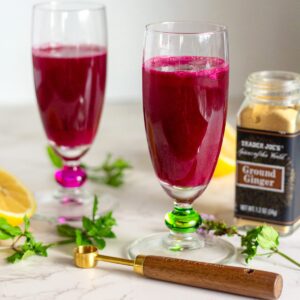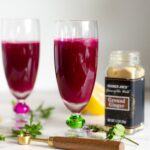Beet Lemon Juice with Ginger (Juicer Recipe)
Refreshing Beet Lemon Juice with Ginger recipe that combines the vibrant flavors of beets, the zesty kick of lemons, and the spicy warmth of ginger.
Servings: 2 people
Calories: 143kcal
Ingredients
- 1 beetroot medium size
- 1 lemon
- ¼ cup maple syrup
- ¼ teaspoon ginger powder
Instructions
- Prepare the ingredients: Wash the beet and lemon with a vegetable brush using clean running water. Peel the beetroot using a vegetable peeler. I used Magic Bullet Mini Juicer in this recipe. I typically don't peel the lemon, and my juicer is processing fine. Cut the beet and lemon into small chunks for easier processing and place them in a large bowl.

- Set up your juicer: Make sure your juicer is clean and ready to use. Follow the manufacturer's instructions for your specific juicer model.
- Begin juicing: Start by feeding the beet chunks through the juicer one at a time. Use a pusher to help guide the ingredients through the juicer. Next, feed the lemon wedges. If you use fresh ginger root instead of ginger powder, feed it next to your juicer (you don't have to peel it; wash it thoroughly).

- Collect the juice: As the ingredients are juiced, the liquid will come out of the juicer's spout. Collect the juice in a glass or container.
- Strain the juice to remove foam: Place a fine mesh strainer over a clean container or pitcher. Pour the freshly juiced beet and lemon juice through the strainer. The strainer will catch any foam or larger particles, allowing only the liquid to pass through. Use a spoon to gently press down on the foam in the strainer to help extract more juice from it. Discard the foam and any solids that remain in the strainer.
- Add the sweetener: Pour maple syrup into a strained juice and stir until the juice blends.
- Serve and enjoy: Beet lemon juice is best served fresh, so enjoy your nutritious and refreshing juice immediately. If you prefer a chilled beverage, pour the juice over ice, add ginger powder to your taste, stir well, and enjoy!

- Note: I had about 1 ¼ cups of juice with this recipe (see the video).
Video
Notes
- Refer to the post above for video instructions and other useful information.
- Nutrition information is an estimate and will depend on your specific ingredients.
- Instead of ginger powder, you can use a 1-inch piece of fresh ginger root.
- I strongly encourage you to use fresh juice of lemon, but bottled lemon juice can also be used if you don't have fresh lemons handy.
- I like using maple syrup here, but my mom frequently made beet lemon juice with regular sugar. In general, you can substitute ¼ cup maple syrup with 2-3 tablespoons of granulated sugar (but you'll have to dissolve it in a bit of water before you add it to the juice).
- Agave nectar can be used as a maple syrup substitute in a 1:1 ratio. Keep in mind that agave nectar has a milder flavor than maple syrup.
- If you like using honey instead, use a 1:1 ratio. Honey is sweeter than maple syrup, so be aware that it may make the juice a bit sweeter.
- Select fresh beets and lemons for the best flavor and nutrition. Look for beets that are firm and not overly wilted or soft.
- The amount of ginger you use can significantly affect the spiciness of the juice. Start with a small piece and add more to taste. Ginger can be pretty potent, so a little goes a long way 😏.
- Add apples or apple juice, carrots, other fruits, favorite veggies, and leafy greens to customize your juice for added sweetness or flavor variation.
- If the juice is too tart, add more maple syrup, honey, agave nectar, or another sweetener to balance the flavors. Stir well to combine.
Nutrition
Serving: 1glass | Calories: 143kcal | Carbohydrates: 36g | Protein: 1g | Fat: 0.2g | Saturated Fat: 0.03g | Polyunsaturated Fat: 0.1g | Monounsaturated Fat: 0.02g | Sodium: 37mg | Potassium: 302mg | Fiber: 3g | Sugar: 28g | Vitamin A: 25IU | Vitamin C: 31mg | Calcium: 65mg | Iron: 1mg
